
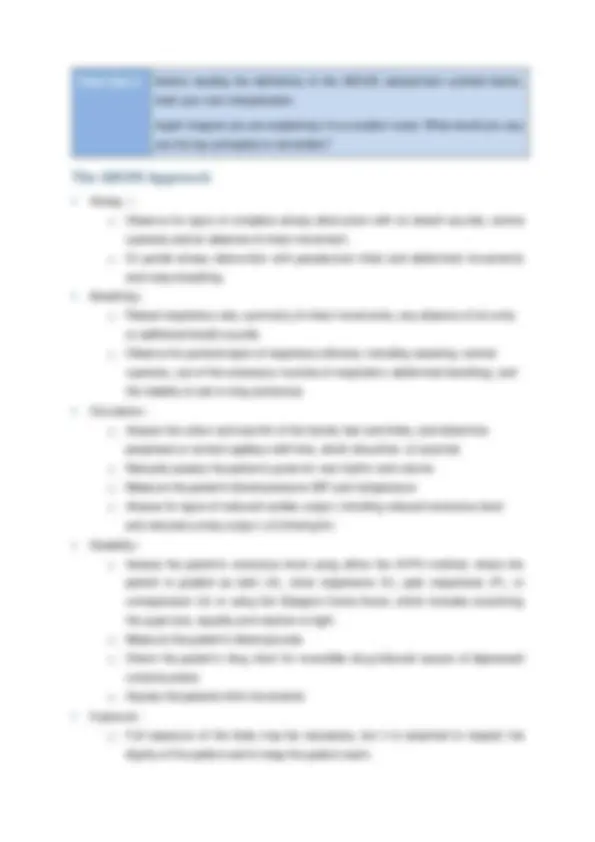
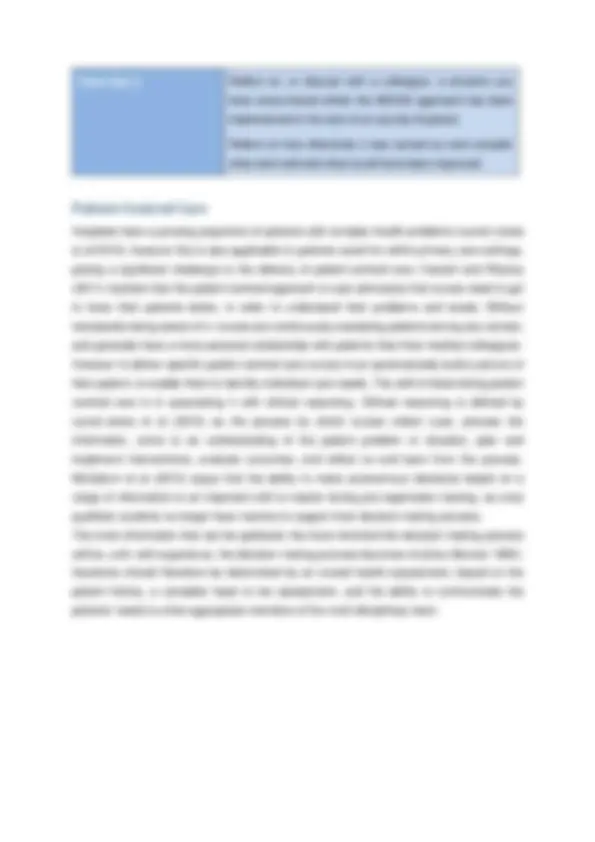
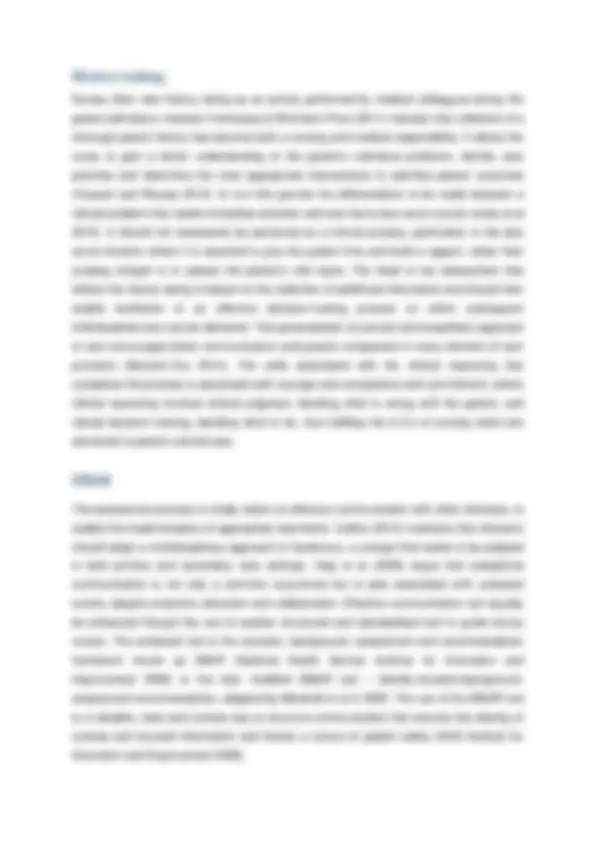
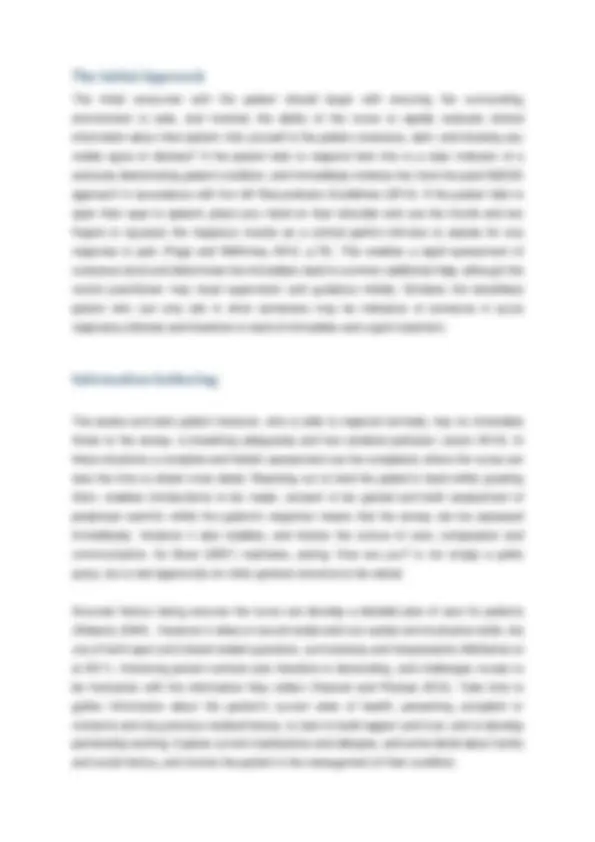
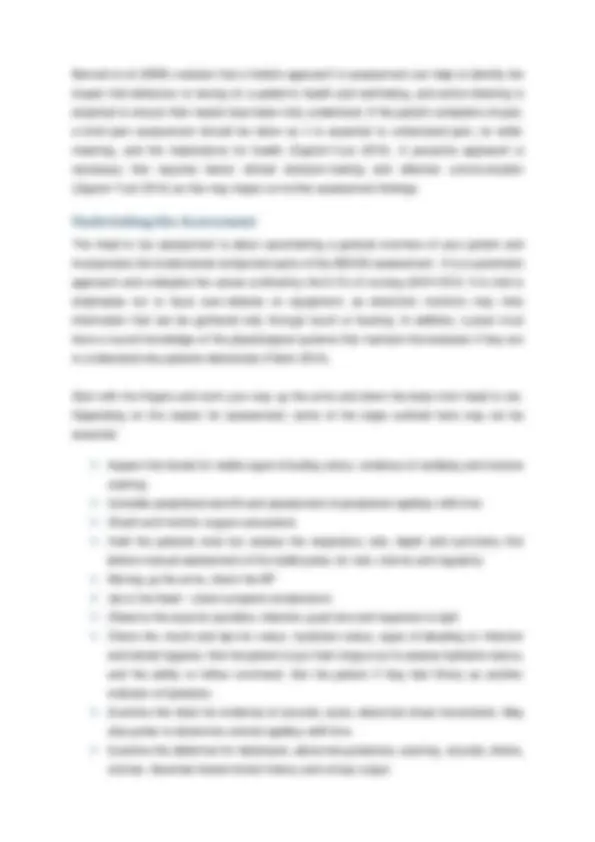
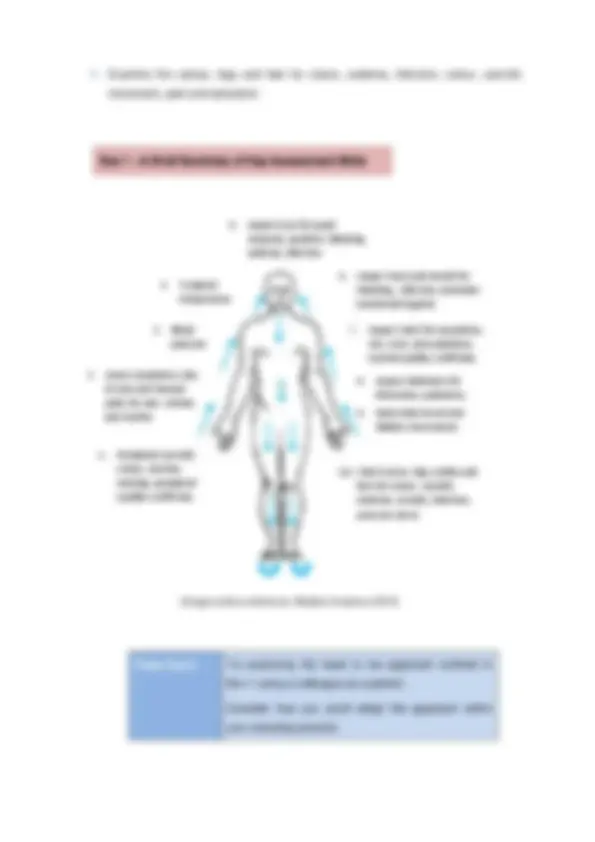
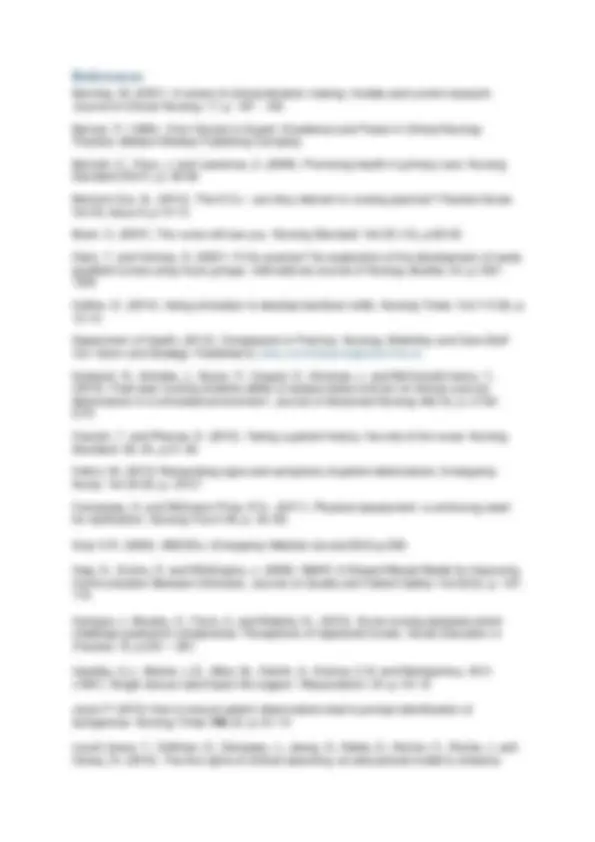
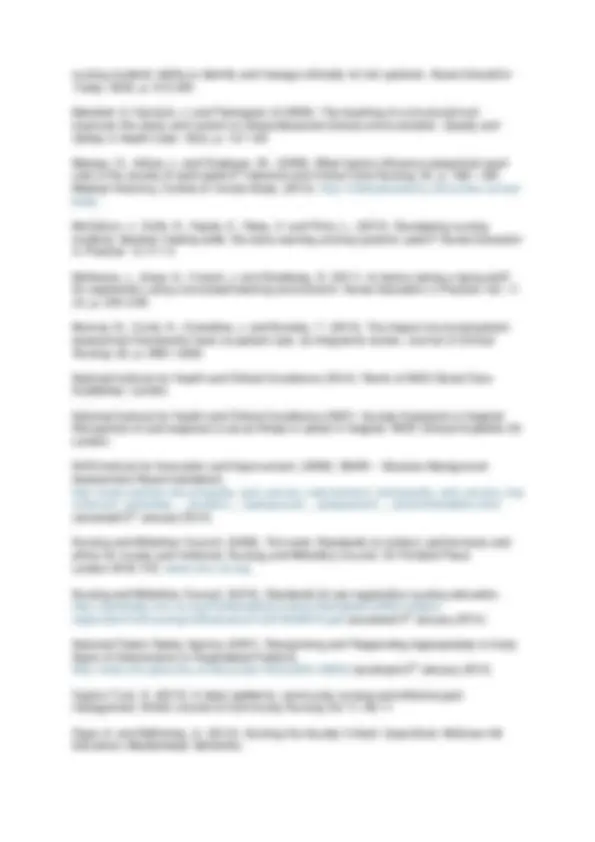
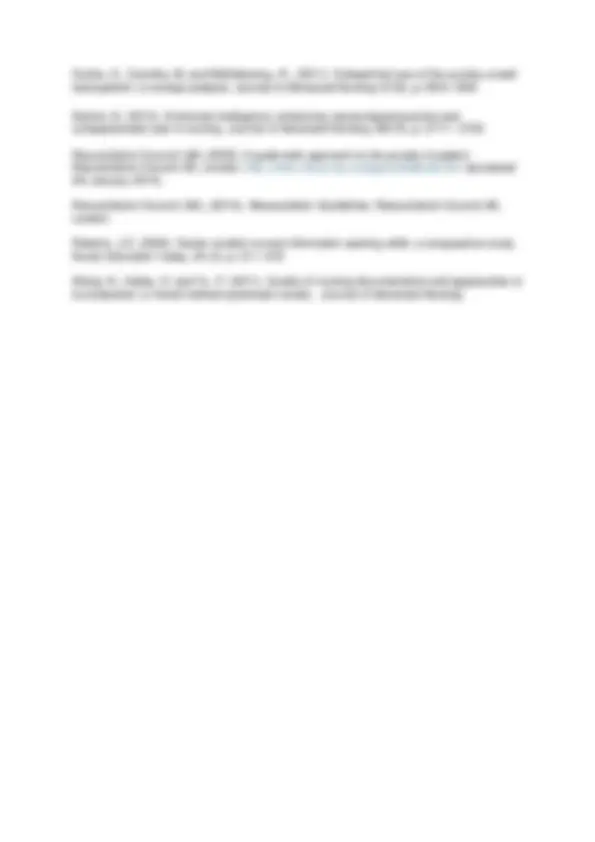


Study with the several resources on Docsity

Earn points by helping other students or get them with a premium plan


Prepare for your exams
Study with the several resources on Docsity

Earn points to download
Earn points by helping other students or get them with a premium plan
Community
Ask the community for help and clear up your study doubts
Discover the best universities in your country according to Docsity users
Free resources
Download our free guides on studying techniques, anxiety management strategies, and thesis advice from Docsity tutors
Examine person-centred care, underpinned by the '6 C's' of nursing. ➢ Undertake a structured patient assessment, following key steps and using a.
Typology: Study Guides, Projects, Research
1 / 15

This page cannot be seen from the preview
Don't miss anything!










After reading this article you should be able to: Understand systematic assessment frameworks; ABCDE; head-to-toe; SBAR Examine person-centred care, underpinned by the ‘6 C’s’ of nursing Undertake a structured patient assessment, following key steps and using a systematic approach Explore the impact decision making has on the provision of high quality individualised patient care Consider information gathering, history taking and documentation as essential parts of the assessment process
Healthcare is changing rapidly in both primary and secondary care, with health care professionals (HCPs) needing to consider more complex care needs, higher expectations, new skills and responsibilities and greater multi-disciplinary team working (Department of Health (DOH) 2012). In addition to this HCPs must make decisions about care based on the latest evidence and best practice, and should consider the assessment of lifestyle, co- morbidities (Bennett et al 2009), and appropriate timing of an intervention and referral of a patient (National Institute for Health and Care Excellence (NICE) 2014). It has however been well documented that acutely ill hospital patients sometimes receive suboptimal care, due to the inability of HCP’s recognising the deteriorating patient, or because, despite indications of clinical deterioration, HCP’s do not act upon them in a sufficiently timely manner (NICE 2007, Endacott et al 2010). The Resuscitation Council UK (2010) recommends that clinical staff should follow the airway, breathing, circulation, disability and exposure (ABCDE)
treating acutely ill patients, to ensure that acute illness is promptly identified and appropriated managed (Jevon, 2010). Whilst using the Situation (S), Background (B), Assessment (A) and Recommendation (R), known as the SBAR approach ensures an effective handover by helping the HCP to structure essential information. This approach encompasses the use of the Early Warning Scoring (EWS) tool, introduced in 2007 by the National Patient Safety Agency (NPSA) to identify patients at risk of deteriorating. However McCallum et al (2013) argues that EWS systems do not place importance on knowing individual patients, their condition and treatment, and may result in dissonance with decision making skills. This article explores the use of these systematic structured assessment tools in acute situations and conceptualises how nurses may further enhance their decision making skills through the use of a Patient Assessment and Clinical-reasoning Tool (PACT) with every patient contact, not just in acute situations. PACT has therefore been developed to support the use of these sustainable tools in both primary and secondary care settings and also considers how to incorporate the 6 C’s of nursing to enhance patient centred care.
The concept of the ABCDE structured assessment has been widely accepted within healthcare and the nurse is often at the forefront of its implementation. Patients' conditions can deteriorate quickly, and although this is more common in acute clinical areas, it can however happen in any setting, and all nurses should be aware of the signs of deterioration. Particularly as in many cases, patient deterioration actually begins up to 24 hours before a critical phase (Felton 2012). There is a value to simplicity in helping nurses to learn and retain knowledge, and a system based on a simple ABCDE mnemonic has much to commend it (Handley et al 1997), providing the letters consistently mean the same thing (Guly 2003). However despite the simplicity of its concept many student and novice nurses struggle to follow the structured format appropriately, and may omit key parts of the clinical assessment, or miss subtle signs of deterioration in their fear of coping with the emergency situation (Hartigan et al 2010, Levett-Jones et al 2010). Jevon (2010) maintains that the exact details of the ABCDE approach depends on the practitioner’s skills, knowledge and expertise, and it is essential to help the novice nurse to further develop these skills.
of the acutely deteriorating patient? Consider how you would explain this to a health care assistant or student nurse. Reflect on any experience you have had in caring for a patient who has become acutely unwell. Do you feel that the signs and symptoms were detected in a timely manner and that appropriate interventions were implemented?
Munroe et al (2013) argue that systematic assessment frameworks may potentially enhance interaction between clinicians through providing a unifying structure on which to base assessments, ensuring all members of the team caring for a patient are working towards the same goal. Therefore the basis to facilitating effective understanding of the assessment approach, and to improving quality of care, lies in encouraging student nurses to consider an adapted use of the structured ABCDE assessment on all patients’ within their care. The process of structured patient assessment should then become second nature in any environment and with every patient contact, regardless of whether this is in a primary or secondary care setting. As a result the ABCDE assessment becomes part of everyday practice, and is a valuable tool for identifying or ruling out critical conditions in any aspect of practice, not just a tool to use in acute emergencies.
have encountered where the ABCDE approach has been implemented in the care of an acutely ill patient. Reflect on how effectively it was carried out and consider what went well and what could have been improved.
Hospitals have a growing proportion of patients with complex health problems (Levett-Jones et al 2010), however this is also applicable to patients cared for within primary care settings, posing a significant challenge to the delivery of patient-centred care. Fawcett and Rhynas (2011) maintain that the patient-centred approach to care advocates that nurses need to get to know their patients better, in order to understand their problems and needs. Without necessarily being aware of it, nurses are continuously assessing patients during any contact, and generally have a more personal relationship with patients than their medical colleagues. However to deliver specific patient centred care nurses must systematically build a picture of their patient, to enable them to identify individual care needs. The skill of determining patient centred care is in associating it with clinical reasoning. Clinical reasoning is defined by Levett-Jones et al (2010) as the process by which nurses collect cues, process the information, come to an understanding of the patient problem or situation, plan and implement interventions, evaluate outcomes, and reflect on and learn from the process. McCallum et al (2013) argue that the ability to make autonomous decisions based on a range of information is an important skill to master during pre-registration training, as once qualified, students no longer have mentors to support their decision making process. The more information that can be gathered, the more informed the decision making process will be, until, with experience, the decision making process becomes intuitive (Benner 1984). Decisions should therefore be determined by an overall health assessment, based on the patient history, a complete head to toe assessment, and the ability to communicate the patients’ needs to other appropriate members of the multi-disciplinary team.
Nurses often view history taking as an activity performed by medical colleagues during the patient admission, however Fennessey & Wittmann-Price (2011) maintain that collection of a thorough patient history has become both a nursing and medical responsibility. It allows the nurse to gain a better understanding of the patient’s individual problems, identify care priorities and determine the most appropriate interventions to optimise patient outcomes (Fawcett and Rhynas 2012). In turn this permits the differentiation to be made between a clinical problem that needs immediate attention and one that is less acute (Levett-Jones et al 2010). It should not necessarily be perceived as a formal process, particularly in the less acute situation where it is essential to give the patient time and build a rapport, rather than jumping straight in to assess the patient’s vital signs. The head to toe assessment that follows the history taking is based on the collection of additional information and should then enable facilitation of an effective decision-making process on which subsequent individualised care can be delivered. This personalised, structured and empathetic approach to care encourages better communication and greater compassion in every element of care provision (Bostock-Cox 2013). The skills associated with the clinical reasoning that completes the process is associated with courage and competence and commitment, where clinical reasoning involves clinical judgment, deciding what is wrong with the patient, and clinical decision making, deciding what to do, thus fulfilling the 6 C’s of nursing which are elemental to patient centred care.
The assessment process is totally reliant on effective communication with other clinicians, to enable the implementation of appropriate treatments. Collins (2014) maintains that clinicians should adopt a multidisciplinary approach to handovers, a concept that needs to be adopted in both primary and secondary care settings. Haig et al (2006) argue that suboptimal communication is not only a common occurrence but is also associated with untoward events, despite extensive education and collaboration. Effective communication can equally be enhanced through the use of another structured and standardised tool to guide novice nurses. The endorsed tool is the situation, background, assessment and recommendation framework known as SBAR (National Health Service Institute for Innovation and Improvement 2008) or the later modified ISBAR tool – identify-situation-background- assessment-recommendation, adapted by Marshall et al in 2008. The use of the ISBAR tool is a valuable, clear and concise way to structure communication that ensures the sharing of concise and focused information and fosters a culture of patient safety (NHS Institute for Innovation and Improvement 2008).
Table 2 – PACT - Patient Assessment and Clinical-reasoning Tool
ISBAR Nursing Role 6 C’s of Nursing Indentify Introduce self, name and role Identify patient Situation Biographics
Complaint
Welcome the patient Assess name, age and preferred name to establish a rapport. Gather information about the current health status by exploring their current complaint, any concern and the reason for this consultation. Consider a numerical pain score and pain assessment if the patient reports pain
Care, compassion and communication
Use open ended questions
Background PMH Medications Allergies
Determine previous medical history Current medications including over the counter, herbal and illicit drugs Consider any allergies Consider smoking, alcohol consumption and dietary issues and health promotion advice Ascertain family and social history
Communication
Assessment
Start from the hands and work up the arms then assess downwards from head to toe
Airway Is the airway patent? Can the patient talk in full sentences? (^) Competence
Early Warning Score calculation where applicable
Breathing Respiratory rate O2 saturations Depth and symmetry Circulation Temperature Pulse - manual Blood Pressure Fluid status Peripheral circulation Disability AVPU Blood Glucose Drugs Limb movements Exposure Assess the skin both front and back for any scars, sores, ulcers, wounds, rashes Recommendation Plan of care Referrals Treatment
Courage and commitment
The initial encounter with the patient should begin with ensuring the surrounding environment is safe, and involves the ability of the nurse to rapidly evaluate clinical information about their patient. Ask yourself is the patient conscious, alert, and showing any visible signs of distress? If the patient fails to respond then this is a clear indicator of a seriously deteriorating patient condition, and immediately initiates the more focused ABCDE approach in accordance with the UK Resuscitation Guidelines (2010). If the patient fails to open their eyes to speech, place your hand on their shoulder and use the thumb and two fingers to squeeze the trapezius muscle as a central painful stimulus to assess for any response to pain (Page and McKinney 2012, p.76). This enables a rapid assessment of conscious level and determines the immediate need to summon additional help, although the novice practitioner may need supervision and guidance initially. Similarly the breathless patient who can only talk in short sentences may be indicative of someone in acute respiratory distress and therefore in need of immediate and urgent treatment.
The awake and alert patient however, who is able to respond normally, has no immediate threat to the airway, is breathing adequately and has cerebral perfusion (Jevon 2010). In these situations a complete and holistic assessment can be completed, where the nurse can take the time to obtain more detail. Reaching out to hold the patient’s hand whilst greeting them, enables introductions to be made, consent to be gained and brief assessment of peripheral warmth; whilst the patient’s response means that the airway can be assessed immediately. However it also enables, and fosters the culture of care, compassion and communication. As Brant (2007) maintains, asking ‘How are you? is not simply a polite query, but a real opportunity for other general concerns to be raised.
Accurate history taking ensures the nurse can develop a detailed plan of care for patients (Roberts, 2004). However it relies on sound verbal and non-verbal communication skills, the use of both open and closed ended questions, summarising and interpretation (McKenna et al 2011). Achieving person-centred care therefore is demanding, and challenges nurses to be innovative with the information they collect (Fawcett and Rhynas 2012). Take time to gather information about the patient’s current state of health, presenting complaint or concerns and any previous medical history, to start to build rapport and trust, and to develop partnership working. Explore current medications and allergies, and some detail about family and social history, and involve the patient in the management of their condition.
Examine the calves, legs and feet for ulcers, oedema, infection, colour, warmth, movement, pain and sensation
(Image outline reference, Medical Anatomy 2013)
Box 1 using a colleague as a patient. Consider how you could adopt this approach within your everyday practice
Box 1 – A Brief Summary of Key Assessment Skills
The final step of the assessment process involves accurate documentation which should attempt to show what has happened in the assessment process and what the clinical reasoning has been based on. Munroe et al (2013) maintain that the completeness and quality of clinical documentation is enhanced in some clinical environments when a structured patient assessment framework is used. However Wang et al (2011) argue that there are inconsistencies in the quality of nursing documentation because of variations in local requirements, and different documentation systems and terminologies across settings. If written nursing documentation is also based on the structured SBAR format it builds consistency throughout nursing practice and across primary and secondary care settings, enhancing care, communication, competency and commitment to patient safety. However it takes courage to challenge practices that have been ingrained for many years.
principles of the PACT tool if you were asked to assess this patient:
The Nursing and Midwifery Council (NMC) Code (2008) states that nurses must listen to the people in their care, respond to their concerns and preferences, and deliver care that is based on the best available evidence or best practice. Degree-level registration underpins the level of practice needed for the future, and aims to enable new nurses to work more closely and effectively with other professionals (NMC 2010). However, evidence continues to suggest that sub-optimal care exists (NICE 2007, Massey et al 2009, Quirke et al 2011), and we need to provide student nurses with the knowledge and skills to enable them to become independent practitioners.
Box 2 – Case Study Daniel is a 54year old man who was involved in a road traffic accident 6 days ago where he sustained bruising to the ribs and an open but superficial leg wound. He is a known asthmatic controlled with the use of inhalers, but is normally fit and well.
Banning, M. (2007). A review of clinical decision making: models and current research. Journal of Clinical Nursing. 17, p. 187 - 195
Benner, P. (1984). From Novice to Expert: Excellence and Power in Clinical Nursing Practice. Addison-Wesley Publishing Company
Bennett, C., Perry, J. and Lawrence, Z. (2009). Promoting health in primary care. Nursing Standard 23(47), p. 48-
Bostock-Cox, B., (2013). The 6 C’s – are they relevant to nursing practice? Practice Nurse. Vol.43, Issue 9, p 10-
Brant, C. (2007). The nurse will see you. Nursing Standard. Vol.22 (13), p.62-
Clark, T. and Holmes, S. (2007). Fit for practice? An exploration of the development of newly qualified nurses using focus groups. International Journal of Nursing Studies. 44, p.1207- 1220
Collins, G. (2014). Using simulation to develop handover skills. Nursing Times. Vol.110 (8), p 12-14.
Department of Health, (2012). Compassion in Practice. Nursing, Midwifery and Care Staff Our Vision and Strategy. Published to www.commissioningboard.nhs.uk
Endacott, R., Scholes, J., Buykx, P., Cooper, S., Kinsman, L. and McConnell-Henry, T., (2010). Final-year nursing students ability to assess detect and act on clinical cues od deterioration in a simulated environment. Journal of Advanced Nursing. 66(12), p. 2722- 2731
Fawcett, T. and Rhynas, S. (2012). Taking a patient history: the role of the nurse. Nursing Standard. 26, 24, p.41-
Felton, M. (2012) Recognising signs and symptoms of patient deterioration. Emergency Nurse. Vol 20 (8), p. 23-
Fennessey, A. and Wittmann-Price, R.A., (2011). Physical assessment: a continuing need for clarification. Nursing Forum 46, p. 45–50.
Guly H.R. (2003). ABCDEs. Emergency Medical Journal .20(4):p.358.
Haig, K., Sutton, S. and Whittington, J. (2006). SBAR: A Shared Mental Model for Improving Communication Between Clinicians. Journal on Quality and Patient Safety. Vol.32(3), p. 167-
Hartigan, I., Murphy, S., Flynn, A. and Walsha, N., (2010). Acute nursing episodes which challenge graduate’s competence: Perceptions of registered nurses. Nurse Education in Practice. 10, p.291 – 297.
Handley, A.J., Becker, L.B., Allen, M,, Drenth, A., Kramer, E.B. and Montgomery, W.H. (1997). Single rescuer adult basic life support. Resuscitation. 34: p.101–8.
Jevon P (2010) How to ensure patient observations lead to prompt identification of tachypnoea. Nursing Times 106 (2): p.12–
Levett-Jones, T., Hoffman, K., Dempsey, J., Jeong, S., Noble, D., Norton, C., Roche, J. and Hickey, N. (2010). The five rights of clinical reasoning: an educational model to enhance
nursing students’ ability to identify and manage clinically ‘at risk’ patients. Nurse Education Today. 30(6): p. 515-
Marshall, S, Harrison, J. and Flannagan, B (2009). The teaching of a structured tool improves the clarity and content of interprofessional clinical communication. Quality and Safety in Health Care. 18(2), p. 137-
Massey, D., Aitken, L. and Chaboyer, W., (2009). What factors influence suboptimal ward care in the acutely ill ward patient? Intensive and Critical Care Nursing. 25, p. 169— Medical Anatomy, Outline of Human Body. (2013). http://medicalanatomy.net/outline-human- body/
McCallum, J., Duffy, K., Hastie, E., Ness, V. and Price, L., (2013). Developing nursing students’ decision making skills: Are early warning scoring systems useful? Nurse Education in Practice. 13, P.1-
McKenna, L., Innes, K., French, J. and Streitberg, S. (2011). Is history taking a dying skill? An exploration using a simulated learning environment. Nurse Education in Practice. Vol. 11 (4), p. 234–
Munroe, B., Curtis, K., Considine, J. and Buckley, T. (2013). The impact structured patient assessment frameworks have on patient care: an integrative review. Journal of Clinical Nursing. 22, p. 2991–
National Institute for Health and Clinical Excellence (2014). Remit of NICE Social Care Guidelines. London
National Institute for Health and Clinical Excellence (2007). Acutely ill patients in hospital: Recognition of and response to acute illness in adults in hospital. NICE Clinical Guideline 50. London
NHS Institute for Innovation and Improvement, (2008). SBAR – Situation-Background- Assessment-Recommendation. http://www.institute.nhs.uk/quality_and_service_improvement_tools/quality_and_service_imp rovement_tools/sbar_-situation-background-assessment-_recommendation.html. (accessed 5th^ January 2014)
Nursing and Midwifery Council, (2008). The code: Standards of conduct, performance and ethics for nurses and midwives. Nursing and Midwifery Council 23 Portland Place
Nursing and Midwifery Council, (2010). Standards for pre-registration nursing education. http://standards.nmc-uk.org/PublishedDocuments/Standards%20for%20pre- registration%20nursing%20education%2016082010.pdf (accessed 5th^ January 2014)
National Patient Safety Agency (2007). Recognising and Responding Appropriately to Early Signs of Deterioration in Hospitalised Patients. http://www.nrls.npsa.nhs.uk/resources/?entryid45=59834 (accessed 5th^ January 2014)
Ogston-Tuck, S. (2010). A silent epidemic: community nursing and effective pain management. British Journal of Community Nursing Vol 17, No 11
Page, K. and McKinney, A. (2012). Nursing the Acutely Il Adult: Case Book. McGraw Hill Education, Maidenhead, Berkshire.